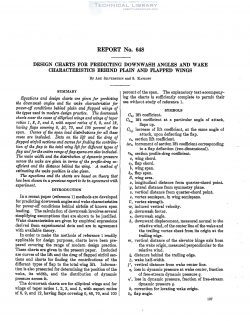naca-report-648

- Version
- 266 Downloads
- 1.66 MB File Size
- 1 File Count
- August 30, 2016 Create Date
- August 30, 2016 Last Updated
National Advisory Committee for Aeronautics, Report - Design Charts for Predicting Downwash Angles and Wake Characteristics Behind Plain and Flapped Wings

Equations and design charts are giren for predicting
the doumwash angles and the wake characteristics for
power-of conditions behind plain and flapped wings of
the types used in modern design practice. The downwash
charts cover the cases of elliptical wings and wings of taper
ratios 1, 2, 3, and 5, with aspect ratios of 6', 9, and 19,
having flaps covering 0, 40, 70, and 100 percent of the
span. Ources of the span load distributions for all these
cases are included. Data on the lift and the drag of
fiapped airfoil sections and curves for finding the contribu—
tion of the flap to the total wing lift for different types of
flap and for the entire range offiap spans are also included.
The wake width and the distribution of dynamic pressure
across the wake are given in terms of the profile-drag co-
efitcient and the distance behind the wing. A method of
estimating the wake position is also given.
The equations and the charts are based on theoryr that
has been shonm in a previous report to be in agreement with
experiment.
In a recent paper (reference 1) methods are developed
for predicting downwash angles and wake characteristics
for power-off conditions behind airfoils of known span
loading. The calculation of downwash involves several
simplifying assumptions that are shown to be justified.
Wake characteristics are given by empirical expressions
derived from experimental data and are in agreement
with available theory.
In order to make the methods of reference 1 readily
applicable for design purposes, charts have been pre-
pared covering the range of modern design practice.
These charts are given in the present paper. Included
are curves of the lift and the drag of fiapped airfoil sec-
tions and charts for finding the contributions of the
different types of flap to the totalwing lift. Infome—
tion is also presented for determining the position of the
wake, its width, and the distribution of dynamic
pressure across it.
| File | Action |
|---|---|
| naca-report-648 Design Charts for Predicting Downwash Angles and Wake Characteristics Behind Plain and Flapped Wings.pdf | Download |

Comment On This Post